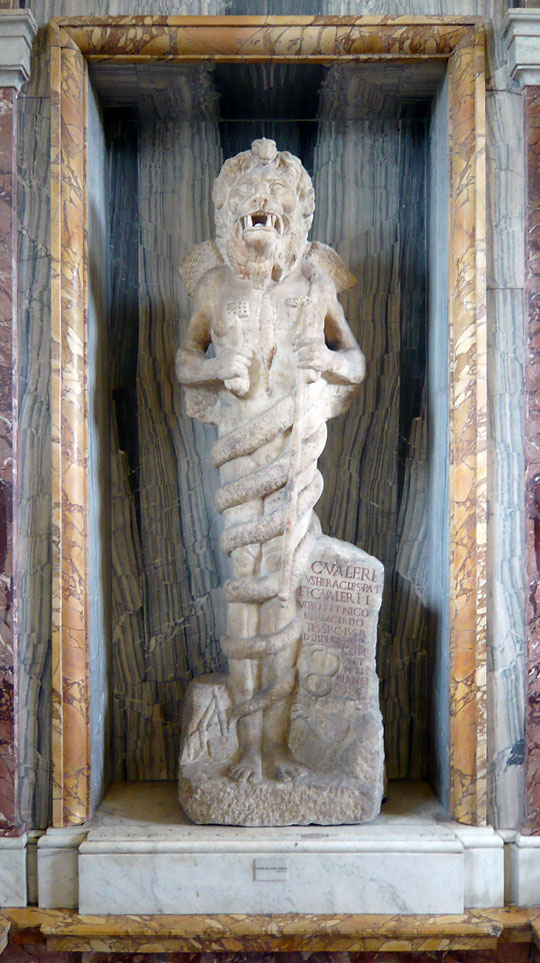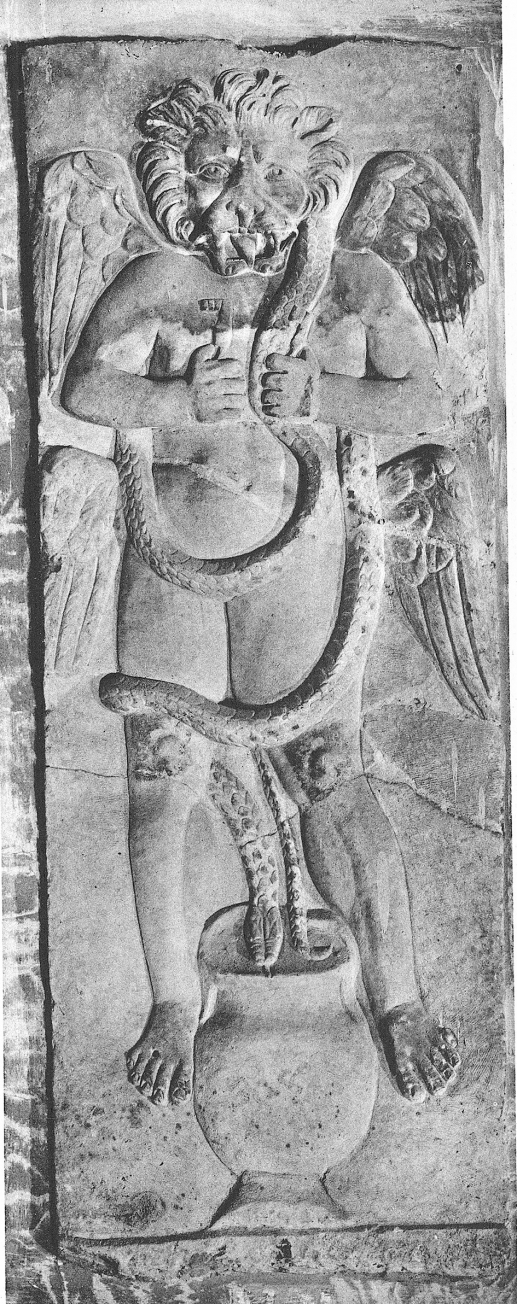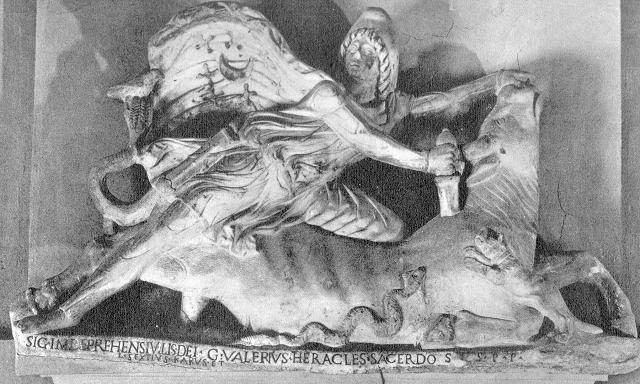Biography
of Gaius Valerius Heracles
- Gaius Valerius Heracles was a Pater of the Mitreo Fagan.
- Active late 2nd century in Ostia, Latium (Italia).
TNMP 19
From the Mitreo Fagan, Ostia, we know of his activity. He was a priest who achieved the highest grade of initiation.
The dedication of an excellent marble leontocephalic statue shows that he flourished at 190 A.C. In another of his inscriptions he professes himself Pater et Antistes Dei Iv(b)enis Inconrupti so(l)is invicti Mithra(e). Pater and priest of the God, the Uncorrupted Youth, the Unconquered Sun Mihtras. Here Incorruptus Juvenis provides a striking variation to the usual formula Deus Sol Invictus Mithras. I would seem that G. Valerius sought to honour his god with inscriptions that departed somewhat from the hackneyed formulas, for we also have a unique epithet on the third remaining monument erected by him, a sculpture of the turoctonic Mithras. The inscription reads: Sig indeprehensivilis dei, statue of the Unsurprisable God.
It would not be unreasonable to assume that this clergyman introduced into his inscriptions epithets familiar from the Latin Mithraic liturgy. Mithras as Indeprehensibilis, lit. ’he who cannot be caught off guard’, is nicely paralleled in the Av. Yast to Mithra (It I0), for example verse 45 ’Protecting in front, protecting behind, a watcher and scanner, undeceivable (adaoyamnō)... with fore-knowing mind, lord of ten thousand spies, omniscient, undeceivable’, or verse 141, ’Victorious, equipped with a well fashioned weapon, watching in darkness, undeceivable; the strongest of the strongest, mightiest of the mighty, most insightful among the divinities; victorious, accompanied by Fortune; he who has a thousand ears, ten thousand eyes, the lord of ten thousand spies, omniscient, undeceivable.’ Indeprehensibilis would correspond most closely to Av. adaoyamna- ’undeceivable’, occurring six times as a standing epithet of Mithra.
—Mithraic Studies: Proceedings of the First International Congress of Mithraic Studies, Volumen 1
The devotee Caius Valerius Heracles appears one time as pater (CIMRM 312-313) and one time as pater et antistes (CIMRM 314-315), and one time as sacerdos (CIMRM 310-311). The priesthoods continue with three devotees appearing as sacerdotes. They are namely Lucius Florius Hermadion and the two brothers of Caius Valerius Heracles, Vitalis and Nicomedes. Moreover, the two Marci Caerellii are called sacerdotes et antistites (CIMRM 223). The overview on Mithraic priesthoods in Ostia is completed by the cases of Caius Caelius Hermeros, who appears in four different inscriptions (CIMRM 254-255, 259, 269-270) as antistes huius loci. As for the term antistes, that means literally chief and supervisor, it seems possible to suggest a role of supervision of a specific sanctuary for the devotees. The album from Portus preserved also a single mention of grade, namely that of is mentioned with pater (CIMRM 325).
[...]
On the matter of the relationship between Mithraic communities and public authorities, local senates are mentioned a few times in inscriptions for the construction or restoration of a Mithraeum. The sanctissimus ordo that means the local senate of the city of Carsulae gave permission at least two times to Mithraic devotees of building their temples. The first inscription testifies to the permission given to the priest Sextus Egnatius Primitivus to re-build a Mithraeum after the previous one was destroyed by an earthquake. Moreover, the second inscription from half a century later mentions nine devotees coordinated by the priest Egnatius Reparatus which were given permission for building a Leonteum, and were given possibly also the land.
The expression loco dato decreto decurionum employed in the text, which means ‘in a place given by decree of the city senate’, seems to be referred to a place given by the civic community to the Mithraic devotees. Again the concession for using a seemingly public space for the set-up of a Mithraeum could be read in inscription CIMRM 315 from Ostia, where Caius Valerius Heracles quotes a crypta, that is a subterranean or semi-subterranean space, given to him (concessa) by a certain Marcus Aurelius ..., possibly an Imperial slave. It seems possible to suggest reading this concession as a long-term rental agreement of an Imperial possession to a local Mithraic community. In another case, the devotee Acilius Pisonianus instead informs us that he bought (comparata) from the city of Milan the land where he built his spelaeum (9).
—Vittoria Canciani (2022) Archaeological Evidence of the Cult of Mithras in Ancient Italy
Mentions
Aion of Mitreo Fagan
The marble Aion from the lost Mithraeum Fagan, Ostia, now presides the entrance to the Vatican Library.
TNMM 116
Aion relief of Mitreo Fagan
This white marble relief depicting a lion-headed figure from Ostia is now exposed at the Musei Vaticani.
TNMM 440
Marble slab with inscription from Mitreo Fagan
This monument bears an inscription that describes the god Mithra as young, which is quite unusual.
TNMM 518
Tauroctony marble from Mitreo Fagan
This sculpture of Mithras killing the bull was dedicated to the ’incomprehensible god’ by a certain priest called Gaius Valerius Heracles.
TNMM 106
p(ecunia) p(osuit).
L(ucius) Sextius Karus et.
And Lucius Sextius Karus.



